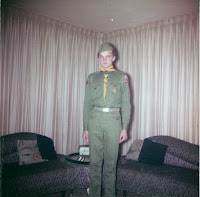I suppose that boys and men who cross-dress, or are
drag-queens, or who are comfortable enough to wear women’s clothes in a play or
at a costume party, and most girls and women have at one time or another used
or wore a scarf as part of their attire.
I am not in one of those categories and have never worn a scarf.
There are several synonyms for “scarf” listed in the Windows
Thesaurus. Cravat, tie, and handkerchief
are three of those. Of course, I have
personally worn a tie many times so I guess one could say that a tie or cravat
is a “manly-scarf”. I have also had a
handkerchief on my person, infrequently, when I was much younger and mother would
insist.
According to Wikipedia at some point in history,
handkerchiefs began life being a kerchief for either a head covering or the
wiping your face or blowing your nose purposes.
To differentiate between the two purposes, the nose type was called a
handkerchief and the head covering became the headkerchief. The latter term I personally have never heard
used, so I suspect it is now in the realm of being an archaic word usage.
 |
| Yellow & Black |
 |
| Blue & Yellow |
 |
| Purple |
 |
| BSA Camp Winton Staff |
I also wore a plaid neckerchief while on the staff of a BSA summer camp.
 |
| Order of the Arrow |
As a member of the BSA’s honor society, Order
of the Arrow, I was given a solid red neckerchief with a large patch on the
back.
I can’t speak for all scouts, but as an adolescent boy, these
neckerchiefs meant a lot to me and they still do. I have many happy memories of that time of my
life with activities our troop engaged in as part of the scouting program.
At that young age, the most common use of a neckerchief is to
identify members of one’s own troop from a distance while camping out with many
other troops during a scouting competition.
The Scout Handbook also contains the more practical though not commonly
needed uses for the neckerchief. Uses
such as a sling for a damaged arm, bandage, tourniquet, sprained or broken
ankle support, and signaling. Wikipedia
also lists many uses one hopes scouts will never need, such as: a gag, a
blackjack, or a Molotov cocktail wick.
The neckerchiefs I displayed in this story are a visual
stimulus to very happy memories which I have not thought of for decades. They were located in a large box where I
placed things about my life that I want my offspring to know about me. I hoped I could find these neckerchiefs to
show all of you but was not sure they still existed. Fortunately, I did find them and spent much
time remembering before I began to write this story, memories I have yet to
write.
I
stored the neckerchiefs away about 41-years ago along with the memories. Now both are back.
© 23 March 2015
About the Author
I was born in June of 1948 in Los Angeles, living first in Lawndale
and then in Redondo Beach. Just prior to
turning 8 years old in 1956, I was sent to live with my grandparents on their
farm in Isanti County, Minnesota for two years during which time my parents
divorced.
When united with my mother and stepfather two years later
in 1958, I lived first at Emerald Bay and then at South Lake Tahoe, California,
graduating from South Tahoe High School in 1966. After three tours of duty with the Air Force,
I moved to Denver, Colorado where I lived with my wife and four children until
her passing away from complications of breast cancer four days after the 9-11-2001
terrorist attack.
I came out as a gay man in the summer of 2010. I find writing these memories to be
therapeutic.
My story blog is, TheTahoeBoy.Blogspot.com.


No comments:
Post a Comment